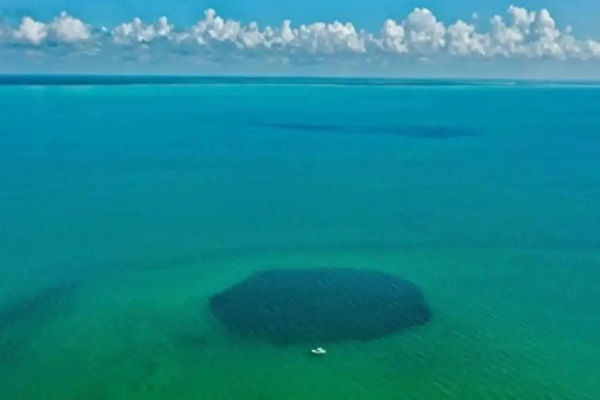**Mexico’s Tama Ja’ Blue Hole: The World’s Deepest Underwater Mystery**
Mexican marine scientists have recently confirmed that the Tama Ja’ Blue Hole, located off the coast of the Yucatán Peninsula in Mexico, is the deepest blue hole discovered to date. However, due to limitations in exploration technology, the exact depth is currently known to be at least 420 meters.
A research team from Mexico published their latest findings in the journal “Frontiers in Marine Science,” indicating that the Tama Ja’ Blue Hole in Chetumal Bay extends to a depth of at least 420 meters below sea level. As exploration tools have not reached the bottom yet, the true depth of the blue hole remains unknown.
This mysterious giant blue hole was first discovered in 2021, with initial measurements using an echo sounder suggesting a depth of around 275 meters. It was not until recently that marine scientists used the most advanced equipment available to obtain more precise measurements.
In December last year, researchers conducted an in-depth exploration of the blue hole, deploying a small high-precision underwater measuring instrument known as a CTD profiler, capable of automatically measuring the physical, chemical, and optical properties of water. The device, fixed to a cable, was lowered by advanced diving explorers into the blue hole for remote-controlled measurements.
However, due to the profiler’s maximum operating depth of 500 meters and potential cable drift or contact with underwater structures during deployment, the instrument stopped operating at a depth of 420 meters. Therefore, the current confirmed depth of the Tama Ja’ Blue Hole is at least 420 meters.
Data from the profiler also suggest the presence of multiple branching tunnels extending in different directions within the blue hole. The temperature and salinity conditions below 400 meters were found to be similar to hydrological data from coastal reef lagoons near the Caribbean Sea, indicating the potential existence of extensive cave or tunnel systems connecting the deep reaches of the blue hole to other underwater caves or the sea.
Researchers plan to further explore this mysterious cavern to unravel the mysteries of its depth and intricate internal structure.
In geological terms, blue holes are underwater sinkholes, considered one of the world’s top ten geological wonders, largely formed from limestone dissolution. Most blue holes are believed to have formed during the Ice Age when lower sea levels exposed these underground chambers. As the glaciers melted and sea levels rose towards the end of the Ice Age, these cavities were submerged by seawater, giving rise to the blue holes we see today.
Prior to this discovery, the record-holder for the world’s deepest blue hole was the Dragon Hole in the South China Sea, with a depth of approximately 301 meters. Other famous underwater sinkholes include Belize’s Great Blue Hole (depth of about 122 meters), Egypt’s Dahab Blue Hole (depth of 130 meters), and the Dean’s Blue Hole in the Bahamas (depth of 202 meters).

